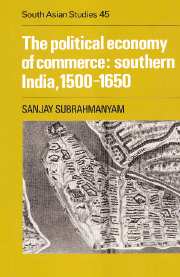Book contents
- Frontmatter
- Contents
- List of illustrations
- List of tables
- Preface
- Abbreviations used
- Introduction
- 1 The political economy of southern India, 1500–1650: preliminary remarks
- 2 Coastal trade and overland trade: complementarities and contradictions
- 3 Overseas trade, 1500–1570: traders, ports and networks
- 4 Overseas trade, 1570–1650: expansion and realignment
- 5 Europeans and Asians in an age of contained conflict
- 6 External commerce and political participation
- 7 Situating trade: models and methodological strategies
- Conclusion
- A note on currency and weights
- Glossary
- Note on sources
- Bibliography
- Index
- CAMBRIDGE SOUTH ASIAN STUDIES
2 - Coastal trade and overland trade: complementarities and contradictions
Published online by Cambridge University Press: 13 January 2010
- Frontmatter
- Contents
- List of illustrations
- List of tables
- Preface
- Abbreviations used
- Introduction
- 1 The political economy of southern India, 1500–1650: preliminary remarks
- 2 Coastal trade and overland trade: complementarities and contradictions
- 3 Overseas trade, 1500–1570: traders, ports and networks
- 4 Overseas trade, 1570–1650: expansion and realignment
- 5 Europeans and Asians in an age of contained conflict
- 6 External commerce and political participation
- 7 Situating trade: models and methodological strategies
- Conclusion
- A note on currency and weights
- Glossary
- Note on sources
- Bibliography
- Index
- CAMBRIDGE SOUTH ASIAN STUDIES
Summary
Introduction
Trade both on sea and on land in pre-colonial southern India was carried on in two sets of commodities: on the one hand, the high-value goods that for decades caused historians to tar Asian trade with the brush of a ‘splendid but trifling’ activity, on the other hand, the bulky, low value commodities, be they foodgrains or coarse manufactures. It is hazardous to identify these two sets of commodities closely with two sets of trading routes; while the metaphor of ‘rice roads’ and ‘silk roads’ may be an evocative one, there is no gainsaying the fact that the ships carrying Chinese silks or pepper frequently carried rice in quantities as well, while the coastal machuas plying the rivers and coasts of Malabar, Kanara and Coromandel carried not only paddy, areca, timber and coir, but also pepper, ginger and sandal. While most past historical studies have been concerned with the longer-distance maritime trade, the picture would remain incomplete without an analysis of two other complementary forms of trade, coastal trade and overland trade. In this chapter, we discuss these two in turn, with a view to laying the ground for a synthetic view of the interlinkages between the three forms of trade: coastal, overland and overseas.
In the discussion of trade in the two chapters that follow the present one, the focus will be by and large on the more substantial and conspicuous trading centres, the ports that in K.N. Chaudhuri's terminology might be called ‘emporia’.
- Type
- Chapter
- Information
- Publisher: Cambridge University PressPrint publication year: 1990



